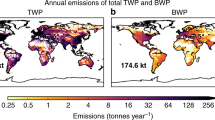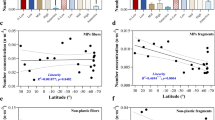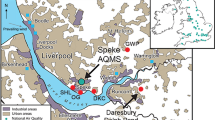Abstract
OVER the past ten years toxaphene has been used in the USA in larger quantities than any other insecticide, with an estimated consumption of 58 million pounds per year (ref. 1). In spite of this widespread use, the composition of toxaphene remains largely undetermined, and recent work indicates that the technical product contains nearly 200 polychlorinated camphenes2. Because of the difficulties in analysing such a complex mixture, little is known about the dissipation of toxaphene in the environment. Residues in soils may persist for years, with volatilisation suggested as a major loss mechanism3. Toxaphene has been identified, however, in US air samples in only three locations4, all in southern agricultural areas, at levels of 16–2,520 ng m−3. The ability of high molecular weight chlorinated hydrocarbons to be transported long distances through the atmosphere has been well established within the past decade. Polychlorinated biphenyls (PCBs)5,6, and the chlorinated pesticides DDT6–9, dieldrin7,9, and chlordane6 have been identified in the air over the western North Atlantic. We now report that toxaphene is also carried through the atmosphere at least 1,200km out to sea.
This is a preview of subscription content, access via your institution
Access options
Subscribe to this journal
Receive 51 print issues and online access
$199.00 per year
only $3.90 per issue
Buy this article
- Purchase on Springer Link
- Instant access to full article PDF
Prices may be subject to local taxes which are calculated during checkout
Similar content being viewed by others
References
von Rumker, R., Lawless, E. W., and Meiners, A. F., Production, Distribution, Use, and Environmental Impact Potential of Selected Pesticides, 196–204 (US Environmental Protection Agency, Washington DC, 1974).
Holmstead, R. L., Khalifa, S., and Casida, J. E., J. Agric. Food Chem., 22, 939–944 (1974).
Guyer, G. E., et al., Toxaphene Status Report, (US Environmental Protection Agency, Washington, DC, 1971).
Stanley, C. W., Barney, J. E., Helton, M. R., and Yobs, A. R., Environ. Sci. Tech., 5, 430–435 (1971).
Harvey, G. R., and Steinhauer, W. G., Atmos. Environ., 8, 777–782 (1974).
Bidleman, T. F., and Olney, C. E., Science, 183, 516–518 (1974).
Risebrough, R. W., Huggett, R. J., Griffin, J. J., and Goldberg, E. D., Science, 159, 1233–1236 (1968).
Seba, D. B., and Prospero, J. M., Atmos. Environ., 5, 1043–1050 (1971).
Prospero, J. M., and Seba, D. B., Atmos. Environ., 6, 363–364 (1972).
Bidleman, T. F., and Olney, C. E., Bull. environ. Contam. Toxicol., 11, 442–450 (1974).
Duce, R. A., Hoffman, G. L., Fasching, J. L., and Moyers, J. L., Technical Conference on the Observation and Measurement of Atmospheric Pollution (TECOMAP), Helsinki, Finland, July 30–August 4 (1973).
Kawano, Y., Bevenue, A., Beckman, H., and Erro, F., J. Ass. off. analyt. Chem., 52, 167–172 (1969).
Murphy, P., J. Ass. off. analyt. Chem., 55, 1360–1362 (1972).
Author information
Authors and Affiliations
Rights and permissions
About this article
Cite this article
BIDLEMAN, T., OLNEY, C. Long range transport of toxaphene insecticide in the atmosphere of the western North Atlantic. Nature 257, 475–477 (1975). https://doi.org/10.1038/257475a0
Received:
Accepted:
Issue Date:
DOI: https://doi.org/10.1038/257475a0
This article is cited by
-
Long-range atmospheric transport of three toxaphene congeners across Europe. Modeling by chained single-box FATEMOD program
Environmental Science and Pollution Research (2009)
-
Organochlorine Contaminants in Water, Sediment and Fish of Lake Burullus, Egyptian Mediterranean Sea
Bulletin of Environmental Contamination and Toxicology (2008)
-
Toxaphen in der Umwelt
Umweltwissenschaften und Schadstoff-Forschung (1998)
-
Preparation and structure of high-chlorinated bornane derivatives for the quantification of toxaphene residues in environmental samples
Fresenius' Journal of Analytical Chemistry (1993)
Comments
By submitting a comment you agree to abide by our Terms and Community Guidelines. If you find something abusive or that does not comply with our terms or guidelines please flag it as inappropriate.



